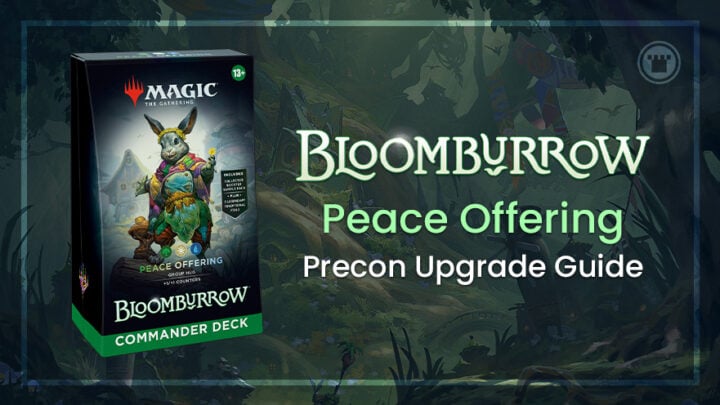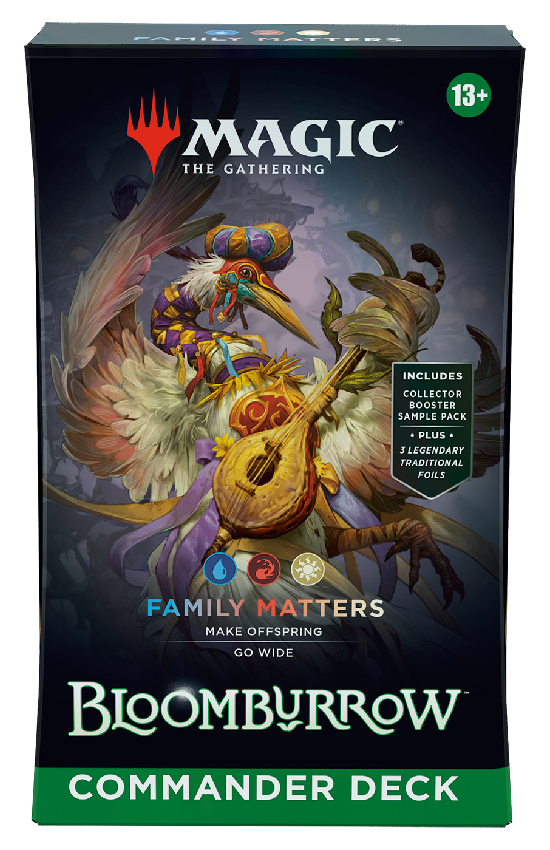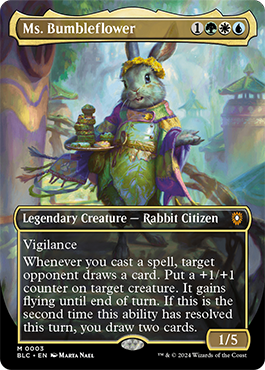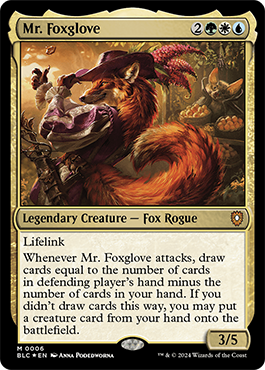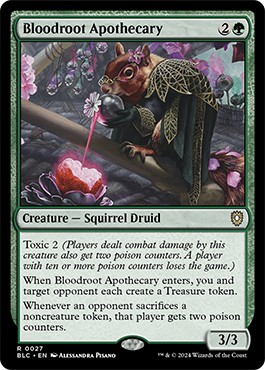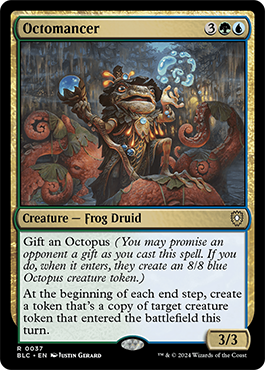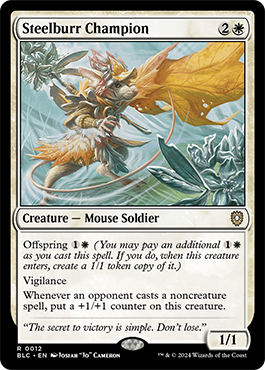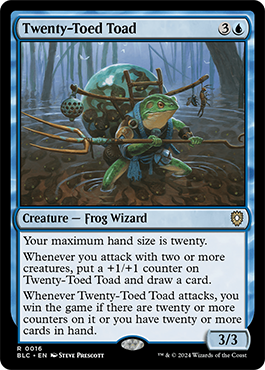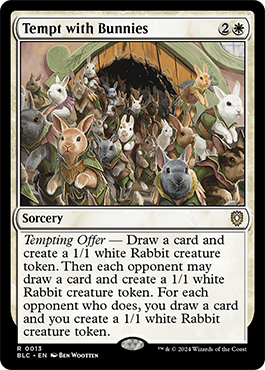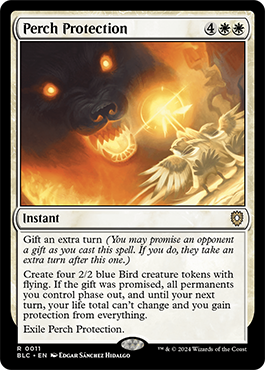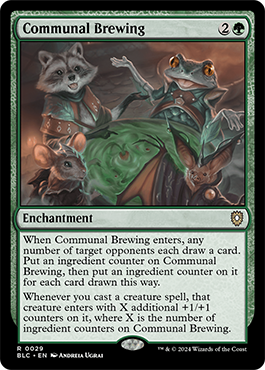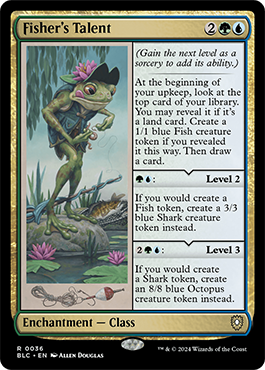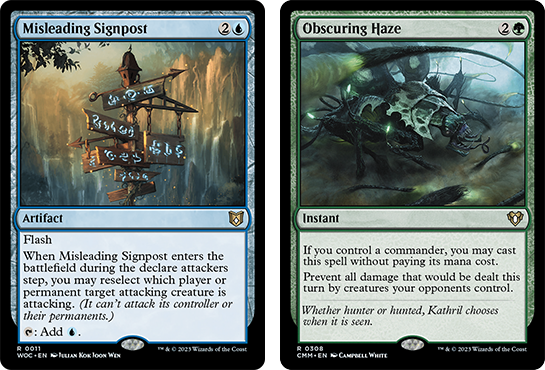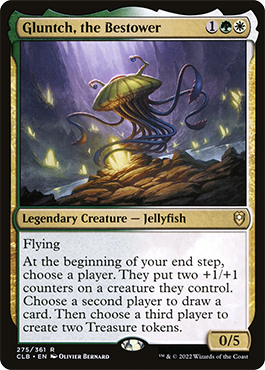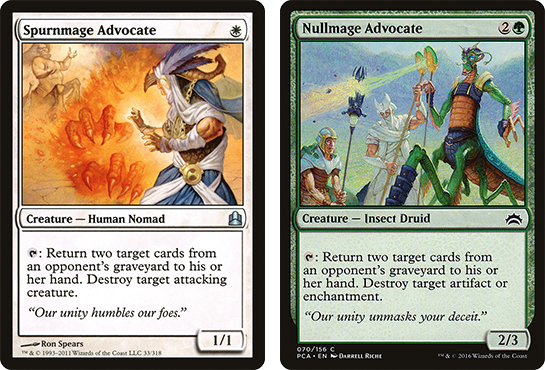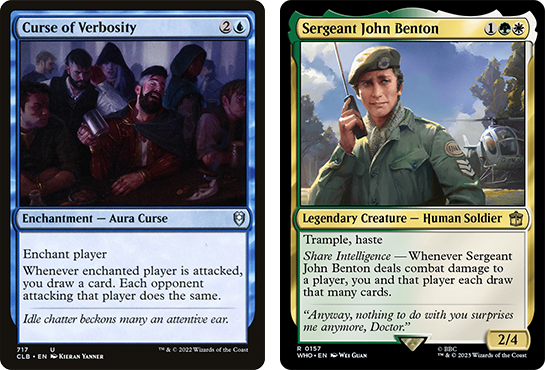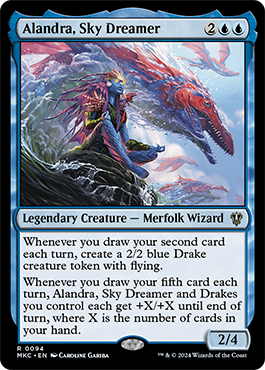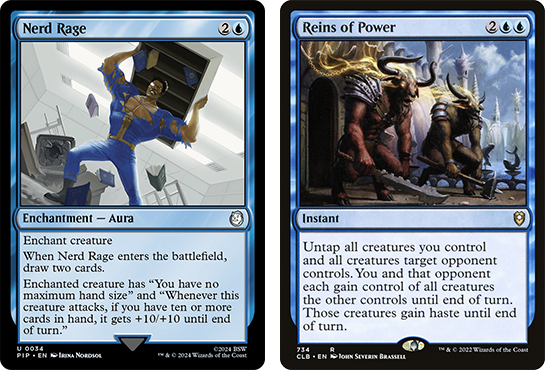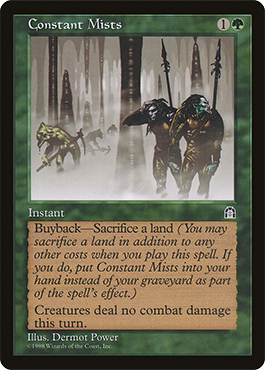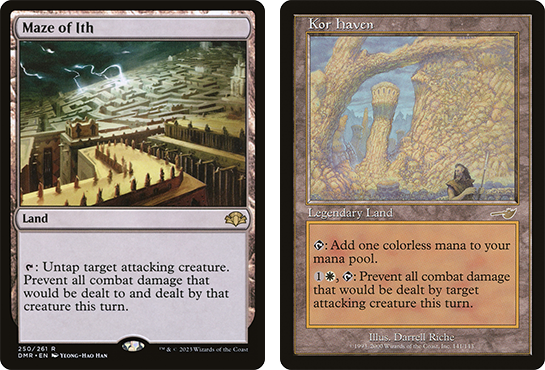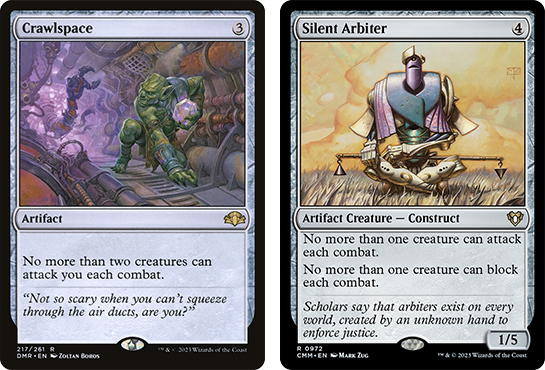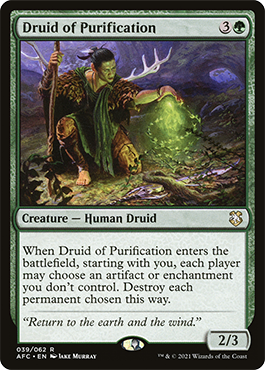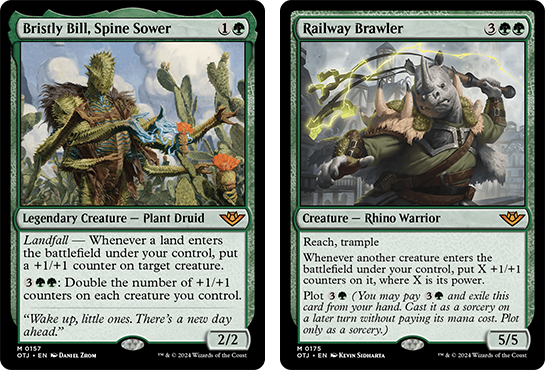Bloomburrow brings with it four new Commander Precon decks, and today we’re focusing on Peace Offering, a rather curious idea for a precon. Not because it’s lackluster or anything like that, but rather because the archetype it embraces, Group Hug, is one of the most tricky and political archetypes to pilot.
That said, the pieces are definitely already here for a good Group Hug deck, and I have a few ideas for how to boost it even further. So without further ado, let’s start with who could be at the lead of this cuddly construction.
New Commanders
Ms. Bumbleflower is a powerful card, but not a terribly straightforward one. She can sling all sorts of political favors around the table, but unless you’re consistently casting two spells a turn, you can very swiftly move from trying to position yourself to win to playing kingmaker very quickly.
That isn’t to say that she’s not a worthy Commander for Peace Offering, just one that requires a very delicate touch. There is a thought at some sort of Voltron strategy that I could see working here, as you load up counters on either Ms. Bumbleflower herself or some other designated threat. As the deck stands in the precon, however, there’s not a ton of support for that idea, so we’ll stick to using her in a more traditional Group Hug strategy.
Mr. Foxglove is good. Like, really quite good. Good enough that I’m pretty sure putting him in the Command Zone would automatically paint a pretty big target on us, something that Group Hug absolutely does not want to have happen right out of the gate. Mr. Foxglove essentially acts as something of an equalizer for us, making sure that as we’re slinging cards and favors around the table for our opponents, we’re able to keep up with everyone and maybe even get ahead a bit by cheating creatures onto the battlefield for free. He’s an absolute killer in our 99, especially when we’re ready to try to turn the corner and go for the win.
Also, he’s simply a stellar addition to most Bant decks, I do highly recommend grabbing a copy of him if you like that particular color combo.
New Cards
Of course, the Commanders aren’t the only new cards in Peace Offering. Let’s take a look at the rest.
Now this is a card designed to stop treasure players right in their tracks…for as long as it takes for someone to get this off the battlefield. Bloodroot Apothecary is the sort of card that an opposing deck can mostly completely ignore or that completely hoses entire strategies, with very little middle ground. Of course, given the right tools in Group Hug, we can make sure that our opponents get plenty of noncreature tokens, although forcing them to sacrifice them is a little trickier. But not impossible.
There’s a chance that Gift becomes one of my favorite mechanics of all time, simply because it gives us such wonderful phrases like “Gift an Octopus.”
That aside, Octomancer leans very into the somewhat deceptive side of Group Hug, in that it grants a very large creature to an opponent right away. If the Octomancer can live to the end step, you then get parity on that large creature, and anything else you get in subsequent end steps is pure upside.
Steelburr Champion is an example of how this deck tries to lean into the counters subtheme, growing larger with each noncreature spell an opponent casts. The fact that it can double itself on casting for less than twice the mana is a nice upside, and that conditional Managorger Hydra effect certainly isn’t anything to sneeze at. But ultimately, I think this will end up being one of the cuts we make to upgrade the deck, as this is a bit lacking as a win condition, its most common use-case likely being to simply gum up the ground a bit. There are certainly decks that want this even slightly different builds of this deck, I just think we can use the card slot a little better.
See, now this is a counters-themed win condition that synergizes quite well with a deck headed up by Ms. Bumbleflower. I don’t necessarily think this card is great to rely on, as either of its win-the-game-right-now conditions will be telegraphed from a mile away and your opponents will have time to react. That said, the sheer number of style points you could get by actually taking down a game with the Twenty-Toed Toad are seriously enticing.
Look. Is this card Bloomburrow-themed shenaniganery? Absolutely. Is it that good? Probably not. But as the cutest addition to the Tempt With cycle, there’s no way I’m cutting it, as its rate still isn’t bad even if no one else takes you up on the temptation.
This card is going to absolutely ruin some friendships. Of all the kingmaker potential in Group Hug, Perch Protection is amongst the most blatant if used at all carelessly. There are ways to stop extra turns from happening, of course. Even if Ugin’s Nexus or what have you is on the battlefield, you’ll still get the phasing and protection effect if you grant an extra turn that can’t be taken. This can also be used to give someone an extra chance to catch up after they’ve clearly fallen behind, or give someone a last, desperate attempt to stop another opponent from running away with the game. This is an inherently powerful card, just try to use it judiciously.
Communal Brewing is an odd one. You should run this card with the expectation that you’re most often only going to end up with a single ingredient counter on it, likely only getting more if you can find a situation where someone is truly desperate to dig for an answer of some sort.
Now, if you can proliferate (something this deck might like to do anyway), you can really start making this scary. Do remember that it’s only creature spells that you cast that get the counters, however. The fact that this won’t buff tokens or creatures put into play any other way does severely lower the ceiling here.
Four mana for a one-sided Howling Mine is already not the worst place to start, although that on its own would hardly be impressive. A four-mana one-sided Howling Mine that occasionally makes you 1/1s is nothing to sneeze at. A total of six mana for those to be 3/3s is quite good, especially since you can make that happen on a payment plan. 10 total mana to make 8/8s? Especially if you have any way to manipulate the top of your library? I’m not saying this is anywhere close to cEDH-worthy, or even great in our deck here, but it certainly isn’t bad.
$50 Upgrade
Now onto the tricky part – how do we make the deck better, and what do we cut to make room? First, it helps if we don’t die while we get everything set up.
Peace Offering already has some tools to stop combat damage from getting through, but adding a couple more in Misleading Signpost and Obscuring Haze seems like a good idea. Signpost can be very funny, very political, or both, and the added ramp isn’t bad either. And it’s hard to beat a casting cost of potentially free with Obscuring Haze, a fine fog to add to the list.
It’s hard to think of a Group Hug deck nowadays without including Gluntch, so that’s exactly what we’re going to do. Gluntch is great at politics while also feeding you whatever need at that point of the game – ramping you early, drawing you cards once you’re established, and pumping up whatever threat you may to close out a game.
It’s hard to understate how useful these Advocates can be in Group Hug, as they both take care of problems while also garnering favor around the table. As with most of the cards here that involve giving your opponents immediate resources, be cautious, of course, in what exactly you’re giving an opponent to work with out of their graveyard. But the name of the game in this deck is to stretch out the game as long as you can until everyone else starts taking each other out of the game, and these two are great at that.
An easy way to make it to the end game is to incentivize attacking other people, and Curse of Verbosity does exactly that. Sergeant John Benton goes even a step further, potentially making opponents welcome an attack from you with no blocks in exchange for some sweet, sweet card draw.
Alandra, Sky Dreamer pairs nicely with Jolrael, Mwonvuli Recluse as a nice payoff for drawing your second card each turn, something that you should be able to do with alarming regularity. While the second mode on Alandra might be trickier to activate than Jolrael, it’s still well within the realm of possibility for this deck.
We do need to close the game out eventually, and if Jolrael and Alandra aren’t cutting it, then we have these two cards. Slap a Nerd Rage on Ms. Bumbleflower and go to town with some commander damage, or, if your board is relatively empty, simply trade it with the scariest army someone else has amassed on the battlefield with Reins of Power and knock them out of the game.
With the upgrades taken care of, here’s what we cut to make room:
- Communal Brewing
- Steelburr Champion
- Rites of Flourishing
- Intellectual Offering
- Tempt with Discovery
- Coveted Jewel
- Swords to Plowshares
- Chasm Skulker
- Realm-Cloaked Giant
- Farseek
After those cuts and additions, here’s the list we end up with.
Further Upgrades
First, let’s get the obvious out of the way – Precon manabases can always use an upgrade. There’s a lot of enters-tapped lands in this list, and even just replacing some of them with basics might be a good idea. But you can get as expensive as you want with swapping those out, so we’ll leave that up to individual taste.
Let’s assume the above upgrades are for a slightly more casual, perhaps less bloodthirsty table. The ones below are for those tables where things can move a little faster, politics maybe don’t hold as much sway, and you just need to find ways to slow things down.
Why settle for one fog when you can have Constant Mists? Best paired with some sort of Crucible of Worlds effect, sometimes folks just knowing you have this card in hand can forestall them attacking all together, at least until someone can dig for some way around it.
If some attacks do get through your various fogs, having Maze of Ith and Kor Haven can spare you the brunt of most attacks.
If you really want to get the most out of the above lands, consider Crawlspace and Silent Arbiter. While these might not stop a dedicated Voltron deck, this can severely slow down most other decks that need to push combat damage though each turn.
Often times giving your opponents a choice is less than ideal, but the worst they can do with Druid of Purification is choose nothing. So the floor here is a slightly over-costed Reclamation Sage, which is definitely worth running when the potential upside is a Reclamation Sage with four times the enters-the-battlefield effect.
If you really want to boost the +1/+1 counters subtheme in the deck (going for that Twenty-Toed Toad/Simic Ascendancy win, eh?), then throwing in Bill and the Brawler give that plan an immediate shot in the arm that can raise the viability of those win conditions right quick.
Hug It Out
As I said way back in the introduction, Peace Offering is a bit of a wild idea for a normal Precon. As we’ve shown, the deck certainly has the ability to execute the Group Hug Gameplan. especially after the few tweaks we’ve given it. But Group Hug is not something I would consider a very beginner-friendly archetype to pilot, meaning this might be the first Commander precon that I’d steer true beginners away from as an introduction to the format. I think I view this deck as more as a step for players looking to take that next intermediate step after learning the ropes, which is a very cool theoretical space to design for, and a space I think is a little underserved at the moment.
So, the Peace Offering given here is certainly worthy, and there’s lots of different directions you could take a deck like this. Do you like Group Hug decks? What’s your favorite way for decks like this to try to win?

Chris is the Marketing Communications Coordinator (and editor of the blog) at Card Kingdom. He would like to apologize to his son for not holding onto more cards from when he first started playing, as that likely would have paid for college. He enjoys pretty much all formats of Magic, but usually ends up playing decks that make other people dislike playing those formats with him.

